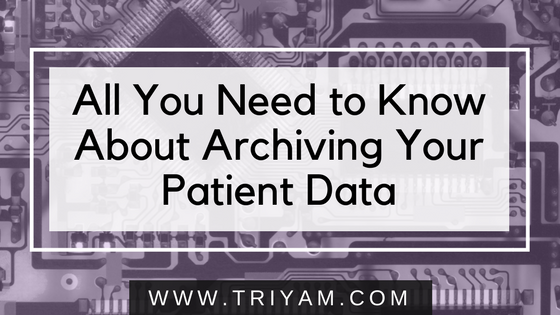Archiving data from your EHR isn’t as scary as it sounds. However, some precautions need to be taken and rules must be followed to ensure you don’t lose any precious patient data as well as meet the necessary legal standards.
Data conversion generally refers to moving data from a legacy system to a new system, and usually, only the most recent clinical data is what gets converted – like a snapshot of the patient’s current health. We recently went over the 3 steps of data conversion (scope, extraction, and cleaning), but what happens to the historical data that is still in the legacy system and not converted into the new system? You guessed it; archival. After all, we can’t just toss out all the history!
What is Data Archival?
Data archiving is the process of moving data from your old EHR/EMR to a safe place for long-term retention. Most of the time this will consist of data that isn’t being actively used, but is still important or may be needed in the future for legal compliance as well as for Release of Information. Data archiving is often confused with backing up data, but it serves different purposes. You backup data by making a copy of it in case it were to be destroyed or lost. You archive data to take reduce storage consumption/cost while still having access to it.
Where Does the Patient Data Go?
Once your data has been extracted from the legacy system, cleaned, and consolidated, it’s ready to be moved. EHR Data must be archived in a vendor-neutral EHR archive, such as Triyam’s medical records archival solution called Fovea.
Fovea is a certified web-based solution, which can be hosted in-house or in the cloud. This is a much less expensive alternative and once all documents have been archived into Fovea, the legacy systems can be shut down.
Accessing the Archived Patient Data
If you’re accessing archived data from Fovea, you will be able to assign authorized users who will set up login credentials. You can log in to Fovea on any type of browser and computer to access the archived patient medical records. The user will need only one username and password to log in and access medical records across multiple facilities. Fovea can be accessed from any mobile device and every user is audited in detail.
Archived data access from the new EMR is slightly different, but still integrated with Fovea. Fovea provides an API interface, which allows users to access patient records from any external system through secure channels. Triyam provides HL7, IHE, and custom API support for interfacing. For example, Fovea can be hooked up to the new EHR via an API interface.
Users can then access the archived records in two ways.
The 1st is by directly logging into Fovea. The 2nd is by logging into the new EHR and clicking a button to launch Fovea archival records within the new EHR. This second method of course assumes that the new EHR allows a customized Fovea button within it. The advantage of this is method is that the users don’t have to sign into two different systems and they can quickly access the patient’s historical records while viewing their current medical records in the new EHR.
Regardless of how you decide to archive your data, I hope this article has helped you better understand why it’s necessary, as well as the process itself. If you’re looking for help managing your data or would just like more information, contact us today for a free consultation. We would be honored to assist you in any way we can!

